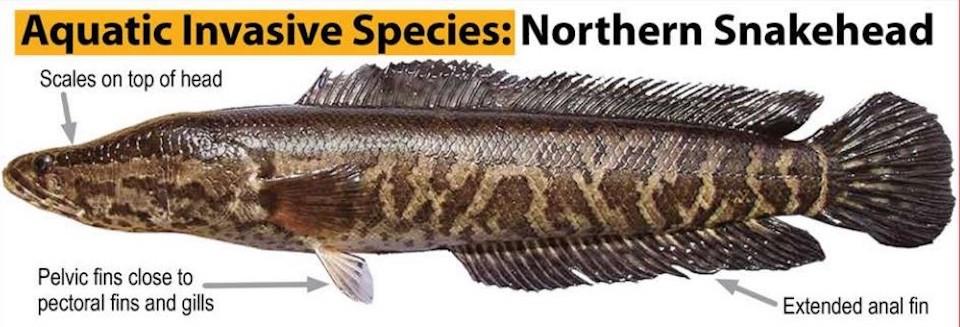
Northern snakehead fish have been found in the Upper Delaware Scenic and Recreational River/NPS
An invader has managed to reach somewhat deep into New York state by swimming up the Upper Delaware Scenic and Recreational River, where it poses a threat to native fish.
A northern snakehead (Channa argus) was recently caught in the river near Callicoon, New York. Park staff say this is of great concern because these non-native invasive fish are predators that potentially threaten important native species and recreational fisheries in the Delaware River. These fish are native to Asia but have been showing up with increasing frequency in other parts of the world recently.
- Do not release it.
- Kill it immediately and freeze it (in case it is requested by fisheries agencies for positive identification).
- If possible, take pictures of the fish, including closeups of its mouth, fins, and tail.
- Note where it was caught (waterbody, landmarks or GPS coordinates).
Report it to:
- The National Park Service ([email protected], 570-493-1022 cell/texts).
- Your regional New York DEC fisheries office (http://www.dec.ny.gov/outdoor/7927.html) or to DEC’s Invasive Species Bureau (518-402-9425 | e-mail us).
-
Pennsylvania Fish and Boat Commission-Report Aquatic Invasive Species-www.fishandboat.com/ais-reporting.htm
- You can also submit a report through iMapinvasives at www.nyimapinvasives.org, or ww.paimapinvasives.org
Do not move it to other waters. Both New York and Pennsylvania prohibit possession, sale, or transport of these fish live.



Comments
Are the dead ones edible?
snakehead are edible, and some folks think their taste is worth a great deal of effort. They were smuggled into the US from Asia for eating, and sold as live fish in markets in the mid-Atlantic. It is likely that a couple of people deliberately released them into local rivers. Tim Collins at Florida International University did some genetics on them about 15 years ago and showed there was more than one introduction from different parts of China or Southeast Asia, but that one or 2 of the introductions had spread rapidly.
Just like any other fish, I certainly wouldn't eat one that I found dead. If you catch one and want to eat it, at least report it to the state folks, record it in iMapinvasives, take a couple of good photos of it, and freeze & retain the head. If there are questions about which species you caught, the head & mouth morphology, plus DNA if necessary, should be enough.
Thanks, and no - I phrased my question awkwardly. I've come across many dead fish, including some beautiful salmon on their return to Alaska, and never considered eating anything that I hadn't personally caught and killed.
I'm old & confused. While Tim Collins told me about snakeheads, his work was on the similar situation with introduced swamp eels.
This USGS report is a good overview of snakeheads, with introductions starting on page 19, and uses on page 24 (both aquarium trade and live food). https://pubs.usgs.gov/circ/2004/1251/report.pdf